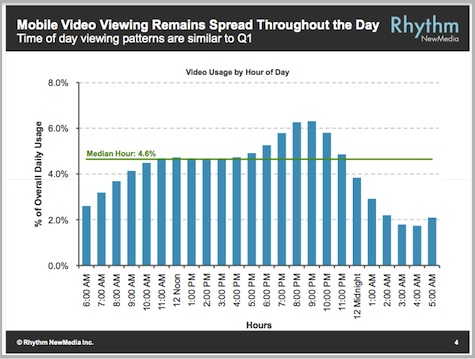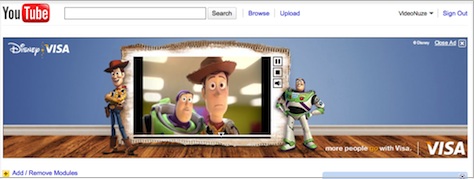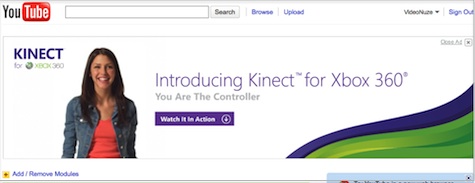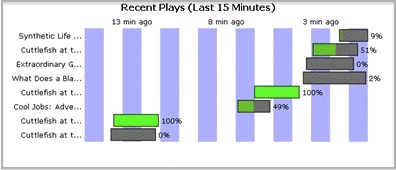-
For Mobile Video, Primetime Continues to be Most of the Time
Rhythm New Media's Q2 '10 mobile video advertising report, which is being released this morning, continues to show how mobile video consumption is spread throughout the day. Unlike online video or traditional TV, where there's a large difference in viewership between the 8pm-11pm primetime daypart vs. other dayparts, the Rhythm data (see below) shows a more even distribution. Rhythms data is based on about 1 billion content views and 75 ad campaigns run during the quarter. Adam Wright reported similar findings in Rhythm's Q1 '10 report.
Categories: Advertising, Mobile Video
Topics: Android, iPhone, Rhythm New Media, ScanScout
-
Stallone's YouTube Video Ad for "The Expendables" Breaks the Mold
If you haven't seen Sylvester Stallone's new video ad now running on YouTube's home page for his upcoming movie The Expendables, take time to check it out it as it completely breaks the mold. It begins as a large banner on YouTube.com (see below). When you click, a standard-looking sit-down video interview between Stallone and TV personality Shira Lazar starts rolling. Pretty quickly the effects begin and you realize this is anything but a standard interview. I won't spoil the fun for you.
The Expendables ad is yet another example of how dramatically online video advertising is opening up the creative palette, allowing brands to do totally unconventional things that get shared and noticed. Another recent example was the Old Spice man ad, which itself became an online video/social media phenomenon. No doubt others will follow. For brands accustomed to operating within the narrow confines of 30-second TV ads, the world is changing fast, and for the better.
What do you think? Post a comment now (no sign-in required).Categories: Advertising
Topics: Sylvester Stallone, The Expendables, YouTube
-
BrightRoll Launches BRX Online Video Advertising Exchange
Online video ad network BrightRoll is launching the BrightRoll Exchange ("BRX") this morning, a self-service online video ad exchange intended to catalyze large-scale, efficient pre-roll video ad buying. BrightRoll CEO Tod Sacerdoti told me yesterday that BRX has been in the works for over a year and began a quiet beta test in April, initially with BrightRoll itself as the primary buyer, and in June with the first 3rd party buyers added. Tod said BRX now has hundreds of publishers participating and thousands of targetable URLs.
and began a quiet beta test in April, initially with BrightRoll itself as the primary buyer, and in June with the first 3rd party buyers added. Tod said BRX now has hundreds of publishers participating and thousands of targetable URLs.
Exchanges have long been important parts of the display ad buying ecosystem and Tod sees online video advertising following the same cycle. Over the past several years more and more brands and agencies have begun buying online video ads, learning about the new medium and its ROIs. Some bigger buyers are already looking to buy at scale, and others will surely follow. However, BrightRoll research suggests that key obstacles remain, with half of publishers it surveyed unable to sell 20% of their online video ad inventory. BrightRoll believes this is primarily due to buying inefficiencies.
Categories: Advertising
Topics: BrightRoll
-
Ooyala Supporting Monetization of HTML5 Video
Online video platform Ooyala is announcing this morning that its HTML5 video player is now supporting dynamic ad insertion for IAB-standard ads. This means that content providers using Ooyala's Backlot platform will be able to monetize video consumed by iPads and iPhones.
means that content providers using Ooyala's Backlot platform will be able to monetize video consumed by iPads and iPhones.
Categories: Advertising, Technology
-
FreeWheel Lands Univision and Scales Up for Live Events
FreeWheel, the video ad management and monetization provider, is announcing this morning that it has landed Spanish-language broadcaster Univision as its latest customer. In the past year, Univision has become one of the most active broadcasters involved with online video, signing a deal to move a large amount of its content to YouTube for distribution, offering full episodes of its telenovelas at a recently-created web site, "Novela y Series," launching a video app for BlackBerry users, and of course most recently, streaming 10 million+ hours of live World Cup games on UnivisionFutbol.com
For FreeWheel, Univision follows Turner, Warner Bros., VEVO, Discovery, CBS and others on FreeWheel's customer roster. Note that Univision had not yet deployed FreeWheel for its UnivisionFutbol.com site but that FreeWheel was inserting ads in ESPN3.com's World Cup online streaming which generated 7.4 million unique viewers and 15.7 million hours viewed. I talked to co-CEO and co-founder Doug Knopper earlier this week, who shared some recent statistics from the World Cup action and discussed how FreeWheel is scaling up to better serve ads in live, as well as on-demand, online video.
inserting ads in ESPN3.com's World Cup online streaming which generated 7.4 million unique viewers and 15.7 million hours viewed. I talked to co-CEO and co-founder Doug Knopper earlier this week, who shared some recent statistics from the World Cup action and discussed how FreeWheel is scaling up to better serve ads in live, as well as on-demand, online video.
Categories: Advertising, Broadcasters
-
VideoNuze Report Podcast #69 - July 23, 2010
Daisy Whitney and I are pleased to present the 69th edition of the VideoNuze Report podcast, for July 23, 2010.
In this podcast I lead off by discussing some further details of Qlipso integrating with Veoh. Daisy weighs in on whether linking virtual economies to online video through social viewing experiences makes sense. I continue to think of Qlipso-Veoh as a fresh approach worth watching.
On an unrelated topic, Daisy then discusses the Old Spice man ad campaign which has taken the online world by storm over the past few weeks, generating 40 million views, 40,000 comments and 100,000 tweets. Daisy is among those impressed with how well Old Spice harnessed social media, but notes that the campaign has been active for months, dating back to the last Super Bowl. Daisy has some additional insight based on an article she's preparing for AdAge next week for which she interviewed the campaign's creative masterminds at the Wieden+Kennedy ad agency. Daisy's conclusion: social media campaigns succeed after lots of preparation and often with the tailwind that traditional media creates. Listen in to learn more.
Click here to listen to the podcast (16 minutes, 12 seconds)
Click here for previous podcasts
The VideoNuze Report is available in iTunes...subscribe today!Categories: Advertising, Aggregators
Topics: Old Spice, Podcast, Qlipso, Veoh
-
VINDICO Gets MRC Accredited
VINDICO, the recently created video ad server division of BBE, is announcing this morning that it has been accredited by the Media Ratings Council (MRC). For those not familiar, the MRC is an independent industry association that works to ensure audience measurement is valid, reliable and effective. VINDICO believes it is the first demand-side video ad server to be accredited by MRC (there may others, I'm not sure; I know that FreeWheel was accredited about 6 months ago).
works to ensure audience measurement is valid, reliable and effective. VINDICO believes it is the first demand-side video ad server to be accredited by MRC (there may others, I'm not sure; I know that FreeWheel was accredited about 6 months ago).
Matt Timothy, VINDICO's president, told me yesterday that the accreditation is a big step forward for both the company, and the online video ad industry. Matt explained that with online video advertising still relatively early-stage, there's been a "Wild West" dynamic with different ad servers and measurement approaches. That friction constrains advertiser spending in the new medium. MRC gives VINDICO new credibility with the agencies and advertisers it serves that the audience data it shares is up to MRC's stringent standards.
With the rise of online video advertising, Matt also sees 2 trends developing: the shift from estimated ad measurement (common in TV advertising) to actual ad measurement and agencies/advertisers taking control of the actual ad delivery process (which in TV advertising is handled by the TV networks and stations). VINDICO is betting on both of these trends; it targets agencies and advertisers with its ad-server technology. Matt pointed to recent wins with VivaKi and Universal McCann as evidence that its approach is working.
What do you think? Post a comment now (no sign-in required).Categories: Advertising, Technology
-
YouTube Aims for Big Screen and Small Screen Success
Not content to dominate online video viewing, yesterday YouTube unveiled new initiatives for viewing on both TVs and mobile devices. Taken together they demonstrate how aggressive YouTube plans to be in the 3-screen viewership era.
First up, YouTube introduced the beta version of "Leanback," the new 10-foot experience that it introduced at the recent I/O conference. With Leanback, you only need to use the 4 arrow keys and Enter key on your keyboard to navigate the YouTube experience. Video plays in full-screen mode and in automatically in HD when available.
navigate the YouTube experience. Video plays in full-screen mode and in automatically in HD when available.
There are different options for what content Leanback delivers: if you have set up subscriptions, it will give you a feed of those videos; in addition, if you've connected your YouTube account to your Facebook account you'll also get a feed of videos your friends are watching/sharing; alternatively, if you've done neither YouTube will simply give you the most popular comedy, entertainment, news, etc. You can also easily search and browse.
Categories: Advertising, Mobile Video
Topics: YouTube
-
Hulu Plus Should Drop the In-Stream Ads Immediately
I activated my 7-day Hulu Plus trial last evening and spent some time with the new subscription service on my Mac. The overall navigation and video quality was excellent, consistent with the high standards Hulu has set from the beginning on Hulu.com. I particularly liked how Hulu has chosen to display the many episodes of past seasons. They are listed by title in reverse chronological order, with run-time, original airdate, length, and the ability to add to your queue well-displayed. For shows with multiple past seasons Hulu Plus lets you drop-down to see particular seasons as well.
Net, net, though I haven't spent a ton of time with it, my first impressions are generally positive, except for one major, major thing: Hulu Plus programs carry the same full in-stream ad load as programs on Hulu.com. In my "7 Quick Reactions" post earlier this week, I called this out as both a big surprise, and also a key detraction from the service. Now that I've experienced the ads, I can say even more emphatically that Hulu Plus must relinquish the ads.
The biggest problem with the ads is that they are discordant with consumer expectations for a paid subscription service. The right comparables for Hulu Plus should be premium cable channels like HBO, Showtime and Epix, and a DVD/streaming service like Netflix. In the former, you'll routinely see cross-promotions for other programs, but you'll never see a commercial break. In the latter, aside from previews, you never see any ads at all.
Categories: Advertising, Aggregators
Topics: Hulu Plus
-
Revision3 is Achieving Unaided Advertising Recall of Up to 99%
When Revision3, the independent network of online video programs, has surveyed its viewers, it has discovered that 99% of them are able to identify at least 1 of its advertisers. That incredibly high level of unaided recall is due to having its program hosts integrate advertiser messages in the middle of its programs, according to Revision3 CEO Jim Louderback, who I interviewed last week. Jim will be a featured speaker at NATPE's upcoming LATV Fest (VideoNuze readers get $200 off registrations). Following is an excerpted transcript.
at least 1 of its advertisers. That incredibly high level of unaided recall is due to having its program hosts integrate advertiser messages in the middle of its programs, according to Revision3 CEO Jim Louderback, who I interviewed last week. Jim will be a featured speaker at NATPE's upcoming LATV Fest (VideoNuze readers get $200 off registrations). Following is an excerpted transcript.
VideoNuze: Revision3 is producing a lot of shows now. Tell us how you decide what new shows to launch?
Jim Louderback: It's a combination of things. We start by asking our viewers what kinds of shows they'd like to see. We scour the Internet - places like YouTube, Vimeo, blip, etc. - to find things that fit with our brands and our 18-34 male target audience. And we apply filters of what we think will work. For example, people told us they wanted a show about movies and so we were able to find a couple of guys in Florida who were making a cool show. We talked to them and refined the program - Film RIot, a little and it's been a big success. Our goal is to combine community with a topic our audience is fascinated by and hosts who are authentic and passionate.
VN: What are Revision3's top 2-3 successes?
JL: Our biggest shows are Techzilla - which is 2 geeks who are passionate about technology; Diggnation - 2 guys talking about social news; and Scam School - built around the concept of using magic to scam drinks off your friends. AppJudgement is doing well as is the Digg Reel, among others. They all come from different places but they've all developed audience and community.
Categories: Advertising, Indie Video
-
Here's What Fox, NBC and Hulu are Doing with Increased Online Ad Loads
Get ready to see more ads in TV programs viewed online. Following my exclusive 2 weeks ago about ABC doubling the number of ads in its iPad app, and soon on ABC.com, the same increased ad load is happening with Fox's and NBC's online programs, and in my opinion, likely with Hulu as well. Here's what I've learned:
Categories: Advertising, Broadcasters
Topics: ABC, CBS, FOX, Hulu, NBC
-
BrightRoll Breaks New Ground with Reporting Suite
Last Thursday's BrightRoll announcement of a suite of 3rd party verified reporting tools, including comScore, Nielsen, Insight Express, and Vizu, breaks new ground is addressing the online video advertising efficacy problem. The suite aims to help marketers understand the actual results of online video campaigns with an eye to driving increased spending in the medium. On Friday, I had a chance to chat with BrightRoll's CEO, Tod Sacerdoti, who explained the reasons for this value-add reporting service.
problem. The suite aims to help marketers understand the actual results of online video campaigns with an eye to driving increased spending in the medium. On Friday, I had a chance to chat with BrightRoll's CEO, Tod Sacerdoti, who explained the reasons for this value-add reporting service.
Tod said that the idea for enhanced reporting came from three problems. The first is that an extraordinarily high number of media buyers - somewhere in the realm of 85% according to BrightRoll's research - did not understand the effectiveness of their online video buys. The second problem was that buyers don't fully use ad networks' in-house analytics and don't fully trust them anyway. Further, as ad spend has poured into online video, so have many low quality networks, who can rely on unsavory tactics to get views and thus lower overall CPMs. Thirdly, internal analytics don't get at the big picture, including for example, how a placement on BrightRoll performs versus a competitor.
Categories: Advertising
Topics: BrightRoll, comScore, Insight Express, Nielsen, Vizu
-
Look Who's Advertising on YouTube's Homepage Now: VISA/Toy Story 3 and Xbox's Kinect
Want a sense of just how far YouTube has evolved from its scruffy user-generated roots to a premier site for big brand launches? Then head over to YouTube.com now and you'll see huge rotating rich media campaigns running for VISA, with a tie-in for the new Disney/Pixar film Toy Story 3 (opening tomorrow) and for Xbox's new Kinect motion-sensing feature (the "Wii-killer" unveiled earlier this week at E3).
From a brand launch perspective, these are about as big as they get, with huge money and franchises at stake for all of the companies involved, not to mention the positive or negative career impact for the marketers driving the media strategies at these companies. The fact that both are advertising prominently on YouTube says volumes about the site's importance in the online advertising world and its evolution from its UGC start.
It wasn't that long ago when YouTube was derided an un-monetizable jumble of amateurish clips. It's also worth noting that, as best I can tell, neither the Kinect nor VISA/Toy Story 3 campaigns are running on Yahoo, AOL or MSN right now, the traditional online homes for big brand launches. Now imagine when YouTube is available on TVs via Google TV and you get a sense of just how important YouTube is going to be, and how strategic it has become for Google which is trying to expand beyond search ads.

What do you think? Post a comment now (no sign-in required).Categories: Advertising, Aggregators
Topics: Toy Story, VISA, XBox, YouTube
-
Exclusive: ABC Has Doubled the Number of Ads in Its iPad App; ABC.com Will Be Next
Yesterday ABC began implementing a new ad policy for its popular iPad app, which up to doubles the number of ads included per episode. ABC intends to apply the new ad policy to programs viewed on ABC.com soon as well. Albert Cheng, EVP, Digital Media for Disney/ABC Television briefed me on the changes last week, adding that he believes the new ad policy will become common in the industry. ABC also shared with me that its iPad app has been downloaded over 800,000 times, with 4.2 million episodes started since the iPad's launch on April 3rd.
changes last week, adding that he believes the new ad policy will become common in the industry. ABC also shared with me that its iPad app has been downloaded over 800,000 times, with 4.2 million episodes started since the iPad's launch on April 3rd.
The changes are very significant as they signal a new push by broadcast networks to improve the profitability of their free online and mobile streams. For example, a typical ABC.com program has included 5-6 ads that are 30-seconds, totaling up to 2 1/2-3 minutes of ad time. This compares with around 20 minutes of ads shown in an hour-long program broadcast on-air.
Categories: Advertising, Broadcasters
-
Digitas' NewFront: Convergence Underway, Challenges Remain
Following this year's successful TV advertising upfront, yesterday Digitas' branded entertainment arm, The Third Act, presented its third annual and playfully titled, Digital Content NewFront. The similarities are in name only though, as the NewFront is a conference and social gathering, bringing together and showcasing top tier online content creators, distributors, and forward-thinking brands.
Before you start thinking NewFront is a bunch of web wannabes looking for their big break, the guest list was actually packed with tons of traditional media talent who have also been pursuing online content, such as Kevin Pollack, Jason Bateman, Lisa Kudrow, Teri Hatcher, and even Martha Stewart. Their involvement underscores how traditional and new media convergence is already well underway, propelled by branded entertainment.
The enthusiasm at the NewFront was abundant, with Mark Beeching, Digitas' Worldwide Chief Creative Officer, trumpeting in his opening remarks, "Online video is no longer a three minute trivial sideshow!" Still, illustrating the mixed motivations of many online content creators, Ricky Van Veen, of CollegeHumor and IAC's branded content wing, Electus, noted that most creators still view online video as a stepping-stone to TV or film.Categories: Advertising, Branded Entertainment, Indie Video
MeFeedia Unveils HTML5 Analytics for All Player
Search engine MeFeedia is announcing this morning a new real-time analytics suite for HTML5 video viewed using the company's All Player.
Content providers using All Player will be able to track a variety of data for video consumed across all devices supporting HTML5 - iPads, iPhones, Android phones and the web. They can view data by summary, recent, popular, devices, videos and channels to monitor an individual or group of videos' performance. Data can also be exported for offline analysis and viewing. The type of data tracked includes view-through rates, time watched, impressions and the viewing device.
As with the All Player itself, the analytics package is free.
The analytics release follows MeFeedia announcing support for HTML5 advertising just before the iPad's recent launch. MeFeedia CEO Frank Sinton explained to me yesterday that though it's still early for HTML5, the company is committed to building out further HTML5 features for the All Player.
For those not familiar with All Player, which MeFeedia launched last June, it's targeted primarily to small and mid-sized content providers who want to improve their ad monetization. All Player's value prop is that it has integrated with key video ad networks, so that once an All Player content provider is approved, it can add or improve monetization immediately. Content providers can use All Player stand alone or in conjunction with their OVP.
All Player has moved MeFeedia from being solely a video search engine to also being a monetization partner. Frank explained that numerous providers now partner with MeFeedia, in some cases simply syndicating a feed of their content, which MeFeedia offers and monetizes through All Player, in turn sending a revenue share back to the content provider. Frank says MeFeedia is fully ad supported and is now profitable. As HTML5 emerges, adding complexity in the short-term to content providers' work flow, tools like All Player look even more important.
What do you think? Post a comment now (no sign-in required).Categories: Advertising, Analytics
Mobile Video Ad Network Transpera Raises $9 Million
Mobile video ad network Transpera is announcing this morning that it has raised a Series C round of $9 million, led by BlackBerry Partners Fund, with participation from existing investors Flybridge Capital Partners, First Round Capital, Intel Capital and Labrador Ventures. Transpera CEO Frank Barbieri told me yesterday that total company funding to date is $18 million.
In addition to the financing, the company is also now promoting its network as "The Audience Network," reflecting what Frank said are significantly higher engagement metrics Transpera campaigns are achieving vs. comparable online video ones. Transpera has worked with brand research firm Insight Express to study performance of 5 recent video ad campaigns that ran on Transpera's network. Compared to norms that Insight Express keeps for similar online video campaigns, for the Transpera campaigns it found 9 times higher increase in purchase intent, 19 times higher increase in aided awareness, 4 times higher increase in unaided awareness and 2 times higher increase in ad awareness.
as "The Audience Network," reflecting what Frank said are significantly higher engagement metrics Transpera campaigns are achieving vs. comparable online video ones. Transpera has worked with brand research firm Insight Express to study performance of 5 recent video ad campaigns that ran on Transpera's network. Compared to norms that Insight Express keeps for similar online video campaigns, for the Transpera campaigns it found 9 times higher increase in purchase intent, 19 times higher increase in aided awareness, 4 times higher increase in unaided awareness and 2 times higher increase in ad awareness.
Categories: Advertising, Deals & Financings, Mobile Video
Topics: BlackBerry Partners Fund, Rhythm New Media, Transpera
Rhythm New Media Releases Bullish Stats on Mobile Video Usage and Ads
A report this morning from Rhythm New Media, a firm that develops mobile video apps for TV programs and runs its own mobile video ad network, provides fresh reasons to be bullish on mobile video. The report is based on an estimated 250 million video views/month that Rhythm has tracked in Q1 '10 on its mobile video platform. Two key stats that jumped out for me: an average 86.7% completion rate and a 1.7% click through rate for its 15-second pre-rolls. The latter is roughly consistent with data Will reported from Rhythm about 6 months ago. It is noteworthy that Rhythm's click through rates are holding steady as it scales up.
To get a sense of how Rhythm's mobile data stacks up against online video advertising data, I compared it to a report eMarketer and YuMe released based on Q4 '09 data, which showed a steady decline in click through and completion rates for pre-rolls. Rhythm's completion and click through rates are 24% and 56% higher than those in the eMarketer/YuMe report. While it's a bit of an apples vs. oranges comparison because YuMe's much larger network includes many different types of video content (vs. Rhythm's TV program only) and the ads YuMe surveyed were a mix of 15-second and 30-second spots (vs. Rhythm's 15-second only), the differences may be an early indicator of the contrast between mobile and online video.
a bit of an apples vs. oranges comparison because YuMe's much larger network includes many different types of video content (vs. Rhythm's TV program only) and the ads YuMe surveyed were a mix of 15-second and 30-second spots (vs. Rhythm's 15-second only), the differences may be an early indicator of the contrast between mobile and online video.
Categories: Advertising, Mobile Video
Topics: eMarketer, Rhythm New Media, YuMe
Brightcove, FreeWheel to Launch HTML5 Video Ad Solution
Building on the momentum around HTML5 and all things iPad-related, online video platform Brightcove and video ad management firm FreeWheel are announcing plans today to launch an HTML5 video ad solution this summer. The companies are already partners and share many mutual customers; the new solution means that customers using both platforms will be able to insert ads on HTML5 compatible devices like iPads, iPhones and iPod Touches when it is available. The move is a positive step for content providers who have rolled out iPad apps but not necessarily with monetization included.
Earlier this year Brightcove unveiled its "Brightcove Experience for HTML5" which auto-detects HTML5 devices, in turn delivering compatible content. Now with the FreeWheel piece, in-stream video ads will be delivered as well. No doubt, as Apple and other non-Flash devices continue to proliferate additional HTML5-focused platform/ad solutions will follow.
What do you think? Post a comment now (no sign-in required).
Categories: Advertising, Devices, Technology
Topics: Brightcove, FreeWheel, HTML5
Digging into Adap.tv's New Real Time Bidding Interface for Online Video Ads
Yesterday video ad management provider Adap.tv introduced a "real-time bidding" (RTB) interface for users of its video ad marketplace, which itself was launched this past February. I'm a big believer that innovations in online video advertising, plus massive online video viewership growth and adoption of convergence devices are together causing big future shifts in brands' ad budgets. RTB is another innovation that over time will help shift budgets. To learn more I spoke to Teg Grenager, Adap.tv's founder and VP of Product last night and have also spent some time reading up on how RTB is working in the display ad sector.
advertising, plus massive online video viewership growth and adoption of convergence devices are together causing big future shifts in brands' ad budgets. RTB is another innovation that over time will help shift budgets. To learn more I spoke to Teg Grenager, Adap.tv's founder and VP of Product last night and have also spent some time reading up on how RTB is working in the display ad sector.
As background, ad exchanges give publishers the ability to expose their content and inventory to interested buyers who can use analytical tools in conjunction to allocate their budgets to better reach their targeted audiences. Exchanges are able to offer more pricing transparency to both publishers and advertisers, with the goal of improving ad performance and ROI. With exchanges, buys are placed in thousands of impressions sizes and in advance, based on anticipated targeting parameters.
As Teg explained, Adap.tv's new RTB feature improves its recently-launched marketplace by allowing ad buying at the impression level with dynamic pricing. The goal is to drive ad effectiveness even higher for advertisers, while still allowing publishers to retain control over their inventory. Teg likened RTB in the marketplace to a next-generation spot market. To use Adap.tv's RTB, the buyer (typically an agency) needs to integrate Adap.tv's API into their own trading desk technology, which as this article suggests are well underway at large firms like Publicis, Havas, The Media Kitchen and others. Once the Adap.tv API is integrated the buyer makes requests to connect with desired publishers for RTB, who in turn can accept or deny access. If accepted the buyer is then able to start bidding on available inventory, alongside other accepted buyers, creating the dynamic pricing environment.
Obviously all of the above is only worthwhile if a large number of publishers are offering inventory to the exchange in the first place and are subsequently willing to allow RTB. Teg said that 700 different properties are currently offering in-stream ad inventory to Adap.tv's marketplace, with hundreds of millions of available in-stream video impressions per month. Though this is only a fraction of the online video market, it seems like a solid start with lots of room to grow ahead. Teg noted that the buy side is in flux, with increasing pressure to be accountable to clients for targeting and ROI (things search marketing has excelled at). RTB caters to these needs.
Longer term the idea of both exchanges and RTB seem like very useful tools to further unlock online video ad spending and shift dollars over from TV. Still, with estimated total online video ad revenue around $1 billion/year, it is clearly early days for many agencies and brands. Many are still just dipping their toes into online video advertising to learn how it performs and will not yet be ready for such hands-on granular bidding. But as these brands and their agencies get more sophisticated, and for others who are already deeply immersed in the market, the idea of a robust ad exchange with RTB will likely be intriguing.
What do you think? Post a comment now (no sign-in required).Categories: Advertising, Technology
Topics: Adap.TV


